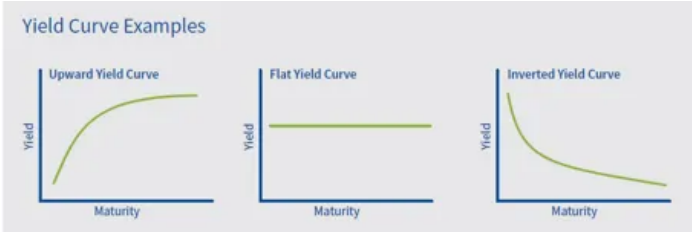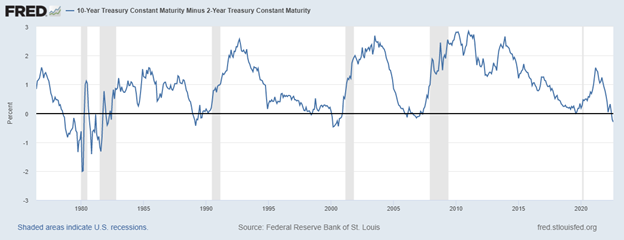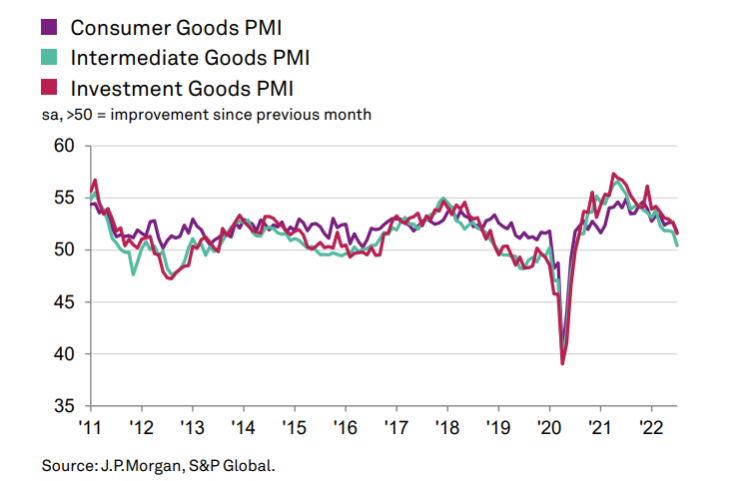While the Federal Reserve continues trying to rein in prices with its aggressive tightening – macro-speculators are busy focusing on the yield curve. Which is now signaling serious trouble ahead for the global economy.
In-fact – according to the recent yield curve inversion (for the second time in three months)– a serious recession is most likely coming.
(Keep in mind that the U.S. is already in a technical recession. Meaning: back-to-back quarters of negative growth so far in 2022).
Let me explain. . .
For starters: what is yield curve inversion?
Putting it simply – it’s when the yield curve begins sloping downwards (i.e. shorter-dated yields are higher than longer-dated yields). Indicating that investors are expecting slower growth and deflation.
This is the opposite of a ‘healthy’ economy – when the curve slopes upwards as longer-dated yields are higher than shorter ones. This is because investors expect rising inflation and higher growth, thus wanting higher yields over longer periods.

Historically, inversion happens when a central bank forces up short-term rates (such as when the Fed hikes the discount rate).
These higher rates tighten financial conditions. And in such a credit-fueled global economy, most often this will lead to slower growth and weaker demand (as debt costs increase, it diminishes marginal spending and borrowing, etc).
Thus – speculators begin thinking ahead – and see that such tightening are the seeds for a future recession.
So they start buying longer-dated bonds, trying to lock-in higher yields while they can before the central bank is forced to cut rates later (as they attempt to fight the recession they effectively created).
In summary – yield inversion is when speculators call the Fed’s bluff about expecting a ‘healthy’ and growing economy. And instead start betting on future economic downside.
Now – why does following the yield curve matter? Because an inverted yield curve has preceded the last eight recessions (with an average 14-month lag – meaning once the curve inverted, a recession hit roughly a year later).
And this is why the most recent inversion is very troubling. . .
To give you some context: back in early April 2022, the U.S. yield curve (the 10-year vs. 2-year spread) inverted for the first time since 2019.
And while it temporarily recovered – it’s recently plunged back into inversion. And at its deepest rate in over 20-years. . .

Currently the 10-vs-2-year spread is negative 0.22 basis points.
This is even deeper than the 2006-07 inversion which preceded the 2008 global meltdown.
But this shouldn’t really come as a surprise. . .
Because over the last few months – there’s been a wave of disappointing economic data appearing all around the world.
For instance – the most recent J.P. Morgan Global Manufacturing Index showed further deterioration.
Such as: business optimism hitting a 26-month low. Global manufacturing in decline. And new orders contracting.

And this is serious dilemma. Especially because the Fed plans to continue tightening.
I recently wrote about the Fed’s blind pursuit in bringing down inflation that it’s causing severe negative ripple-effects. Such as plunging asset prices, rising unemployment, deteriorating growth, and more.
Just take a look at what Minneapolis Fed president – Neel Kashkari – recently told CBS:
“We’re going to do everything we can to avoid a recession, but we are committed to bringing inflation down, and we are going to do what we need to do. . .”
And to make matters worse – the economy’s already in a technical recession. Yet they continue tightening. Compounding the downside.
A big problem’s that the Fed’s focusing on inflation data.
But inflation is a lagging indicator.
Meaning: once inflation begins to fade lower, its already far too late. And a deep recession is most likely already here (hence the falling prices are due to sinking demand).
This is why the U.S. yield curve is so deeply inverted. Speculators believe the Fed’s created a potentially severe recession in its pursuit to lower prices. And will be forced to reverse course and ease aggressively at some point (sooner-than-later) to save the economy.
But for now – it seems like things will only worsen from here. . .
So – in summary – the recent big curve inversion is indicating greater downside ahead.
And if history means anything here – then the risk of a deep(er) recession may happen sooner than many realize.
Since the 1980s – the global economy has become addicted to easy-credit. Thus even minor interest rate increases can ripple into serious problems.
Yet the Fed continues tightening even as the dominos are beginning to fall.
At times like this, it’s important to heed the famous yet-little-followed Austrian economist – Ludwig Von Mises.
He said that easy-money and credit expansion can bring about temporary booms. But most of it is fiction. And it will inevitably lead to a vicious bust.
Time will tell.
Stay tuned.
Disclaimer: I remain long-bonds and U.S. Dollar as of writing this.
